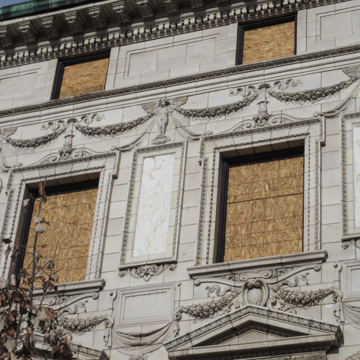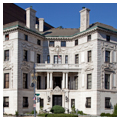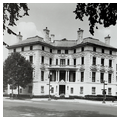You are here
The Washington Club (R. W. Patterson House)
McKim, Mead and White's response to half of one of Dupont Circle's obtuse-ended wedges was to address the circle obliquely (not parallel to the site line) and P Street frontally, with triple-bay, rectangular wings, and to place the entrance between them facing their point of intersection. Thus, when approached from the south, the building's eleven bays appear as a single faceted facade, its two wings tied together by a deep loggia set above the single entrance doorway. The composition derives from a traditional Renaissance palace, with the plain ground story connoting service areas, two highly ornamented principal stories, and a short attic story tucked under the low-slung roof. The highly ornate facade, where the wall surfaces are encrusted with garlands, swags, putti, and escutcheons, specifically recalls several sixteenth-century Roman palaces, such as the Palazzo Spada of 1550. The white, highly polished marble walls are so reflective and the surface ornamentation so profuse that the observer initially suspects glazed terracotta as the sheathing material.
Writing Credits
If SAH Archipedia has been useful to you, please consider supporting it.
SAH Archipedia tells the story of the United States through its buildings, landscapes, and cities. This freely available resource empowers the public with authoritative knowledge that deepens their understanding and appreciation of the built environment. But the Society of Architectural Historians, which created SAH Archipedia with University of Virginia Press, needs your support to maintain the high-caliber research, writing, photography, cartography, editing, design, and programming that make SAH Archipedia a trusted online resource available to all who value the history of place, heritage tourism, and learning.



















